Food and Nutrition Sciences
Vol. 3 No. 6 (2012) , Article ID: 19956 , 12 pages DOI:10.4236/fns.2012.36109
Effects of Lean Beef Supplementation on Iron Status, Body Composition and Performance of Collegiate Distance Runners
![]()
Department of Health & Nutritional Sciences, South Dakota State University, Brookings, USA.
Email: Kendra.Kattelmann@sdstate.edu
Received March 15th, 2012; revised April 26th, 2012; accepted May 5th, 2012
Keywords: Iron Deficiency; Endurance Athletes; VO2max; Lean Beef; Bioavailable Iron; Heme Iron
ABSTRACT
Iron deficiency is prevalent among endurance athletes, particularly females. Low iron may compromise oxygen delivery and physical performance. Vegetarianism, desire for convenience, and perceived health risks associated with red meat contribute to low bioavailable iron intakes. The purpose of this study was to examine if lean beef supplementation would maintain iron status, improve body composition and increase performance of distance runners after 8 weeks. Twenty-eight (14 female) Division-I cross-country runners were stratified by iron status, use of iron supplements, and gender, and randomized into a control (n = 14) and intervention group. All participants maintained their typical diet and consumed a daily multivitamin, while the intervention group consumed 9 ounces of lean beef weekly. Dietary intake (total iron, heme-iron, protein, zinc), body composition, VO2max, and iron status (hemoglobin, hematocrit, serum iron, serum ferritin, total iron binding capacity [TIBC]) were measured at baseline and post-intervention. The intervention group had greater intakes of total and heme-iron. There were no group differences in amino acids, protein, or calories. Both groups had a significant body fat increase and lean mass decease over time. There was a significant VO2max increase over time in both groups. There were no group differences due to the intervention in serum ferritin, hemoglobin, serum iron, and TIBC. There was a significant difference in hematocrit between groups as a result of the intervention. In conclusion, increasing bioavailable iron from red meat may have effects on body composition and maintenance of blood iron markers; however, its direct impact on performance among endurance athletes is unclear.
1. Introduction
Iron is a trace mineral that plays essential roles in the human system. Two thirds of the iron inside the body is found within hemoglobin, an iron-containing protein found in red blood cells that carries oxygen [1]. The remaining iron is located in myoglobin, which assists in the storage and transport of oxygen within muscles [1]. Hemoglobin plays a significant role in exercise, as it transports oxygen throughout the body. If the body has inadequate hemoglobin levels, oxygen delivery to tissues will be compromised and physical performance may then suffer. There is some controversy even among health professionals regarding “normal” hemoglobin concentrations, but the generally accepted ranges are 12 - 16 g/dl for women and 13.5 - 18 g/dl for men [2]. Anemia is the condition associated with hemoglobin concentrations below the defined normal range.
Health professionals have suggested based on previous research findings that athletes, especially females and distance runners, are at risk of developing iron deficiency [1]. Highly physically active individuals are at an increased risk of developing this deficiency when compared to their less-active counterparts. Additionally, females are more likely than males to develop iron deficiency, with 25% - 35% of adolescent and adult female athletes experiencing a form of iron deficiency compared to 10% - 11% of adolescent and adult male athletes [3]. Within the active population the consumption of red meat products is reported at a decreased rate when compared to the general population [4]. Reasons such as vegetarianism and the desire for convenience, along with various perceived health risks associated with red meat may all contribute to this decline [4]. One of the main disadvantages of reducing the consumption of red meat is the potential impact on serum iron and zinc status [2]. Red meat is a rich source of heme iron that has higher bioavailability of these essential nutrients than non-heme iron, which is derived from plant-based sources. Several previous studies addressing performance with an iron supplement found varying increases in endurance time, VO2max, and oxygen consumption with an iron-treated intervention group [5-9]. Subjects who were iron deficient at baseline were noted to exhibit a significant increase in performance measures after supplementation.
Additional iron intake in a dietary form may be of importance to the endurance athlete to prevent iron depletion with consequences of thus, decreased performance. To increase the amount of bioavailable iron in the diet, prepackaged lean beef would be a convenient option for this population. The justified need for this study is to examine the iron status, body composition and performance of male and female collegiate distance runners, to increase the research knowledge on the most effective supplementation for this population. The specific aim of this study is to examine whether supplementation with a lean beef stick will result in maintenance of iron status, improvement in body composition and increase in performance compared to a multivitamin supplement alone. It was hypothesized that supplementation with increased amounts of lean beef would maintain the iron status, and improve the body composition and performance of collegiate distance runners over an 8-week period.
2. Methods
2.1. Subjects
Twenty-eight (14 males and 14 females) NCAA Division I cross country runners from South Dakota State University, who were 18 - 24 years of age, volunteered to participate. Participant characteristics are listed in Table 1. After an explanation of the expected procedure, verbal approval was gained from the head coach prior to recruitment. Individuals who consented to participate agreed to follow their typical training regimen, were willing to consume additional lean beef via the provided beef sticks, and replace the use of any multivitamin supplement with the provided multivitamin. Any use of additional iron supplements during the study duration would be documented. This study was approved by the South Dakota State University Human Subjects Committee.
2.2. Study Design
The participants were stratified according to their baseline iron status, current use of iron supplements, and gender, and then randomized into the control or intervention group. All participants continued to exercise per their regular training regimen throughout the 8-week intervention period. The participants randomized to the intervention group were instructed to maintain their typical diet and consume 9 one-ounce servings (255.15 grams per week) of the lean beef supplement per week, along with the supplied daily multivitamin supplement. The control participants were instructed to maintain their typical diet and consume only the daily multivitamin. The provided multivitamin supplement (Equate® Complete Multivitamin/Multimineral Dietary Supplement) contained 18 mg of iron in the form of ferrous fumarate. The provided lean beef supplement (Silver Creek Specialty Meats®, Oshkosh, WI) contained 6% of the RDA for iron. The multivitamin was distributed to all subjects at baseline while the beef supplements were distributed bi-weekly throughout the study duration. Participants were required to complete a weekly calendar to annotate their beef supplement consumption and multivitamin compliance throughout the week. All documentation and collection was monitored by study personnel.
2.3. Dietary Protocol
All participants were required to complete a 3-day diet history at baseline and again after the 8-week intervenetion. Participants were instructed to record two regular weekdays and one weekend day. The food records were entered into nutritional analysis software titled Food Processor for Windows, 2006 (Database version 10.2, ESHA Research, Salem, OR). Intakes of calories, carbohydrates, protein, total fat, vitamin C, calcium, zinc, heme and non-heme iron were evaluated, along with other key vitamins and minerals. Heme iron was calculated as 40% of the total iron content in the meat products consumed [10]. The remaining 60% was defined as non-heme iron intake. The type, dose, and frequency of iron-containing supplements were also documented in the dietary intakes.
2.4. Blood Draw Protocol
A blood sample was required of all participants at baseline and immediately after the 8-week intervention period. Participants were instructed to refrain from exercise and fast for at least 12 hours prior to their scheduled blood draw. Sampling was performed by qualified personnel using sterile techniques. Duplicate samples of approximately 15 mL of blood were obtained from the antecubital vein via vena puncture. The samples were stored in a freezer (−40˚C) until analysis. The biochemical indicators of iron status assessed included serum ferritin, hemoglobin, hematocrit, serum iron, and total iron binding capacity (TIBC). C-reactive protein levels were measured to indicate the presence of inflammation. For the purpose of this study, serum ferritin levels < 15 µg/L indicated iron deficiency. Iron deficiency anemia was classified by hemoglobin < 12 g/dL for women and < 13 g/dL
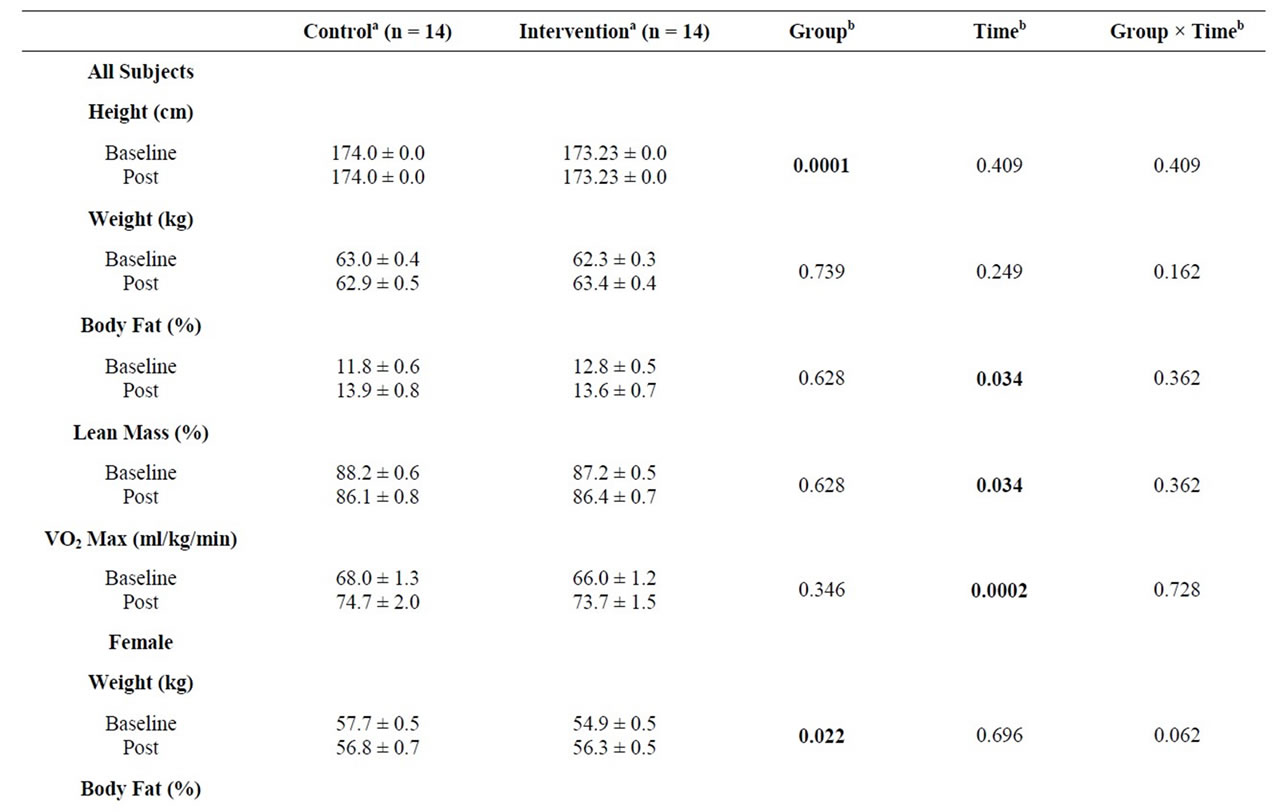
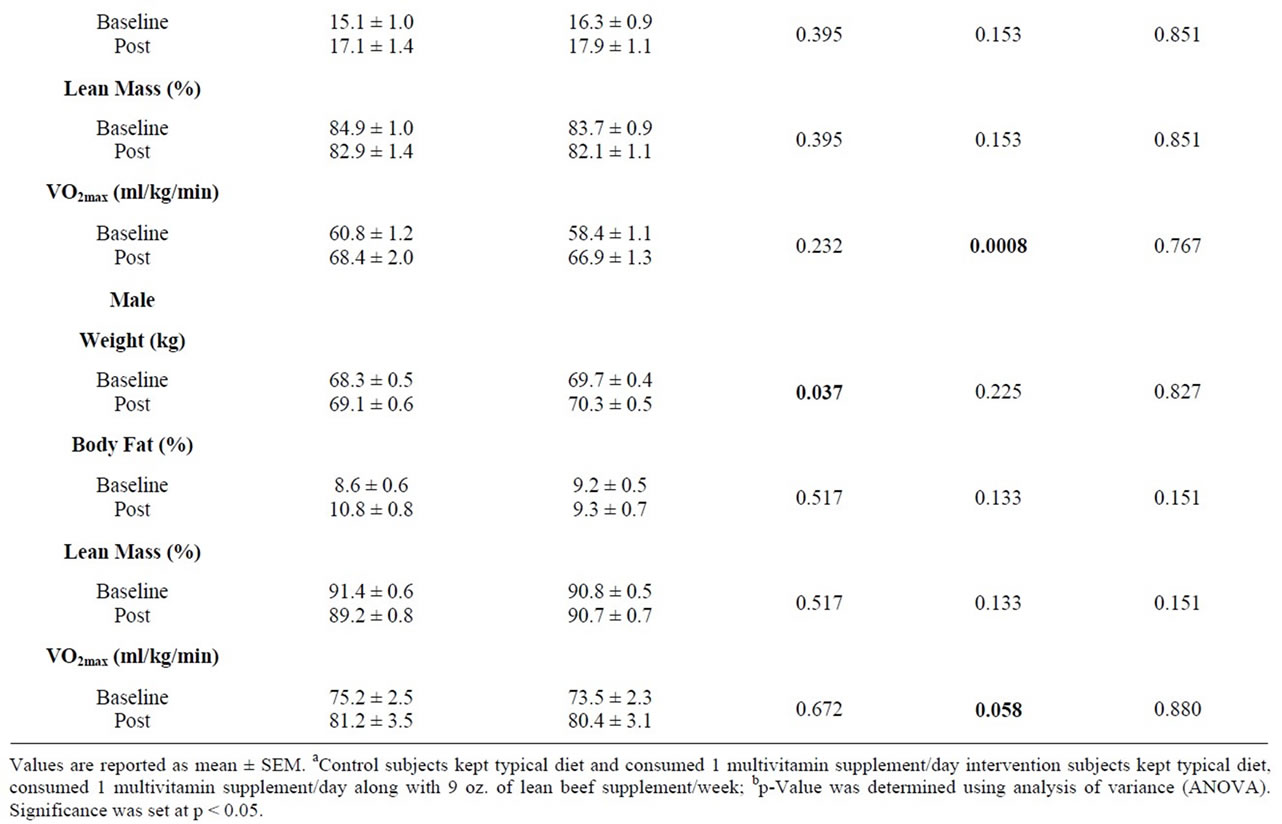
Table 1. Participant anthropometric and performance measures at baseline and 8 weeks.
for men [1,4]. Additional indicators were also used to evaluate iron status: low serum concentrations (<60 μg/ dL), high TIBC (>400 μg/dL), and low transferrin saturation (<16%).
2.5. Body Composition Protocol
Body composition was measured via air displacement plethysmography (ADP; Bod Pod Life Measurement Instruments, Concord, CA) using the procedure recommended by the manufacturer.
2.6. Exercise Test Protocol
Subjects performed a VO2max test using the Parvo Medics TrueOne Metabolic System (Sandy, Utah) at baseline and after the 8-week study duration to measure peak oxygen consumption. Participants were instructed to warm up for 5 - 10 minutes at his or her desired pace. The set starting speed varied between participants and was based on current fitness level and 5-kilometer race pace. All females began at 7.0, 7.5, or 8.0 mph and all males began at 8.5, 9.0, or 9.5 mph. The grade of the treadmill (Woodway, Waukesha, WI) remained constant at 1% for the test’s entirety, and the speed was increased 0.5 mph every minute until the subject reached volitional exhaustion. Heart rate and oxygen consumption (VO2) were monitored throughout the test. The VO2max, or maximum amount of oxygen consumed during the test, was recorded for each participant. All participants were advised to perform the baseline and post VO2max test at a similar time of day.
2.7. Statistical Analysis
Statistical analysis was performed using statistical software (JMP®7, SAS Institute, Cary, NC, USA). Descriptive statistics were represented by mean ± standard error (SEM). A two-way analysis of variance with time (baseline vs post) and group (control vs intervention) was used to determine the main effect of supplementation on all variables measured. A Tukey post-hoc test was used to identify significant differences when a significant F-ratio was obtained. The level of significance for analyses was set at p < 0.05.
3. Results
3.1. Dietary Intake
Twenty-eight athletes (intervention = 14, control = 14) from the cross country team completed the 8-week study. The intervention group had greater intakes of total iron and heme-iron due to the consumption of weekly beef supplements (Table 2). As a result of the intervention, there was a near significant group × time effect in hemeiron intake (p = 0.057), where heme-iron was significantly greater in the post-intervention athletes than the post-control. When separated by gender the female intervention participants had greater heme-iron intakes than the control. These differences were not seen in the males (Table 3). The consumption of Fe(mg)/1000 kcals was significantly different between groups, where from baseline to post the control group consumption decreased 10% while the intervention increased 20% (p = 0.033). A significant effect of time was seen in zinc intake (p = 0.020), where both groups consumed significantly less from baseline to post-intervention (Table 2). The intervention group decreased their calcium intake signifycantly from baseline to post. There was no significant difference seen in calorie, protein, or carbohydrate intake. When separated by gender the females within both groups experienced a significant increase from baseline to post in kcals/kg of weight and carbohydrate consumption. These differences were not seen in the males (Table 3). There were no significant within or between group changes in any amino acid intake (Table 4).
3.2. Anthropometric and Performance Measures
There was no significant weight change over time, although the body fat percentage in both groups increased significantly (p = 0.034). The percentage of lean mass in both groups deceased significantly over time (p = 0.034). When evaluated by gender, there was a significant difference in weight at baseline between groups of females, with the control females weighing more than the intervention (p = 0.022). No significant change was seen between female groups over time in body fat or lean mass percentage. Among the males there was also a significant difference in weight between groups at baseline, with the intervention males weighing more compared to the control subjects (p = 0.037). The body composition of both male groups, measured as body fat and lean mass percentage was not affected as a result of time.
There was a significant increase in VO2max from baseline to post in all subjects. When evaluated by gender, VO2max increased significantly as an effect of time in both groups of females (p = 0.0008). The VO2max was of near significant increase over time in the male participants (p = 0.058) (Table 1).
3.3. Blood Parameters
There were no group differences due to the intervention in serum ferritin, hemoglobin, serum iron, and TIBC. There was a group × time significance in hematocrit (p = 0.051). There was a significant decrease due to time in hemoglobin concentration (p = 0.0001) and serum iron

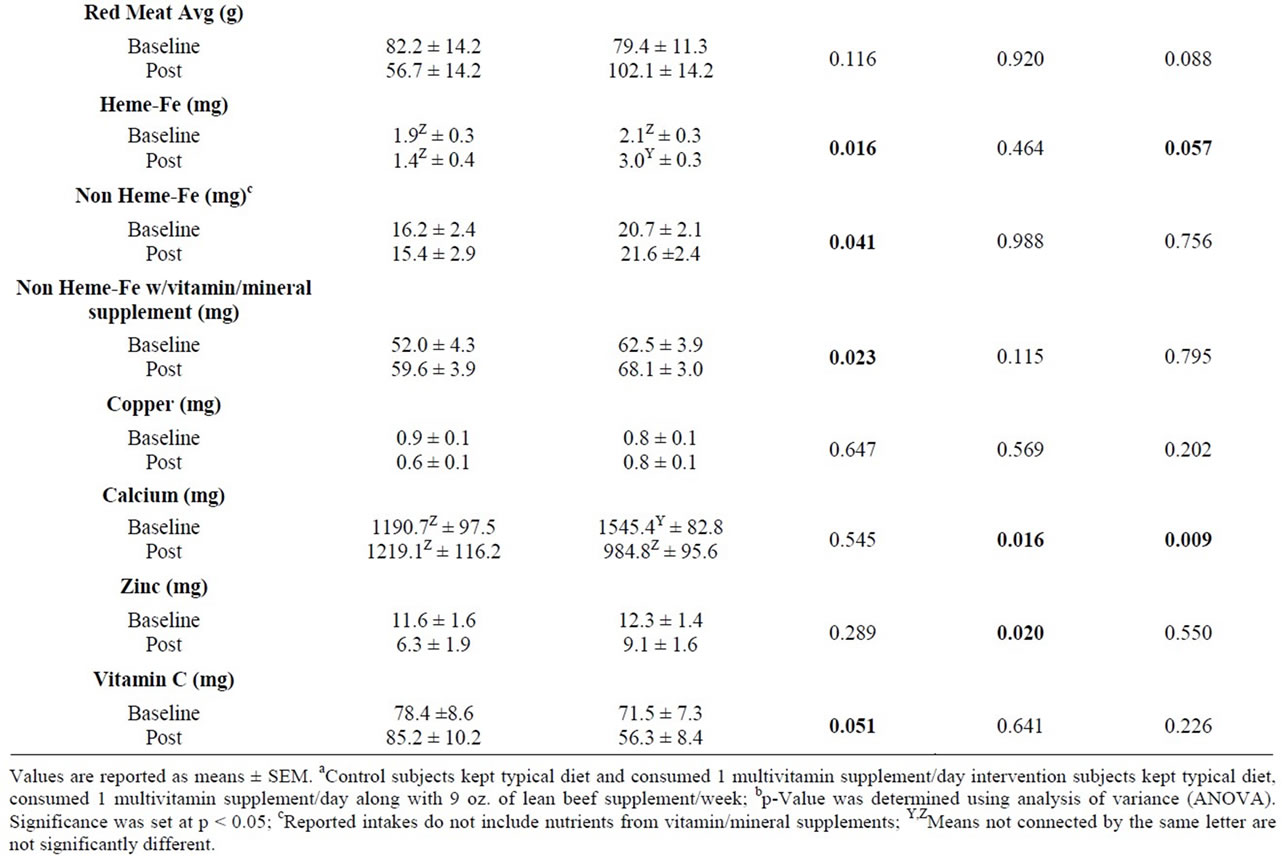
Table 2. Average daily dietary intakes of all subjects at baseline and 8 weeks.
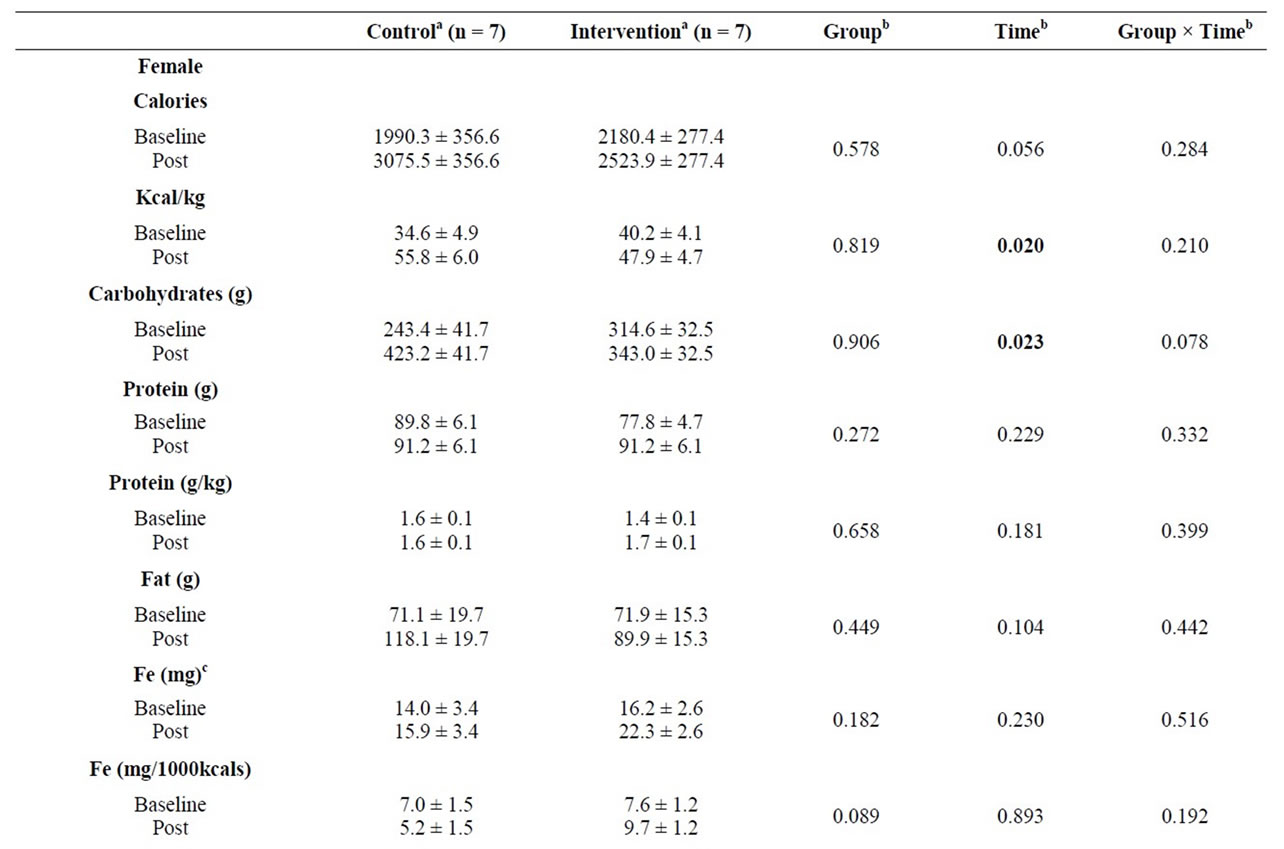

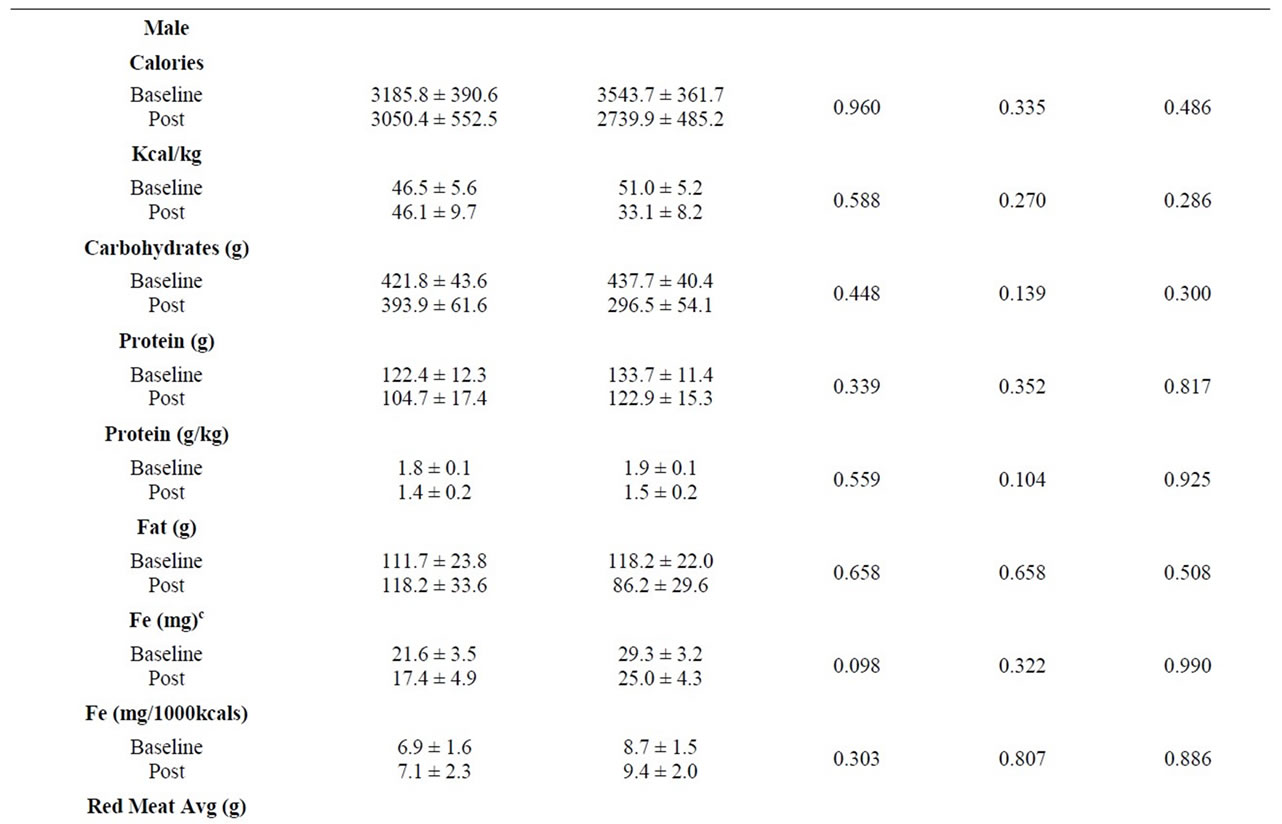

Table 3. Average daily dietary intakes at baseline and 8 weeks by gender.

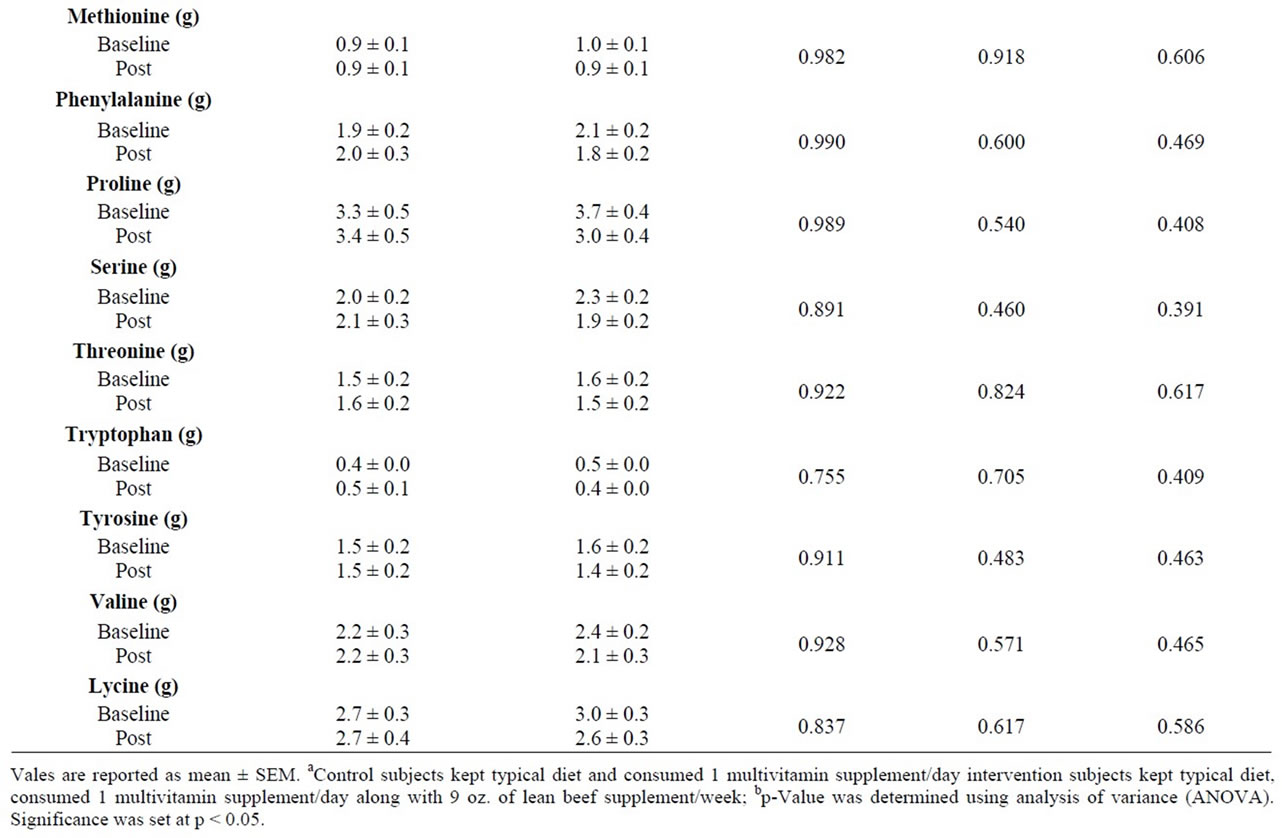
Table 4. Average daily amino acid intake at baseline and 8 weeks.
(p = 0.018) (Table 5).
When the results were evaluated by gender, the females experienced more changes than the males. There was a significant group × time difference between control and intervention female subjects in hematocrit that was not present in the males (p = 0.055). There was a group × time near significance in female TIBC (p = 0.058). The male findings revealed no change in serum ferritin, hematocrit, serum iron, or TIBC in group, time, or group x time effects. There was a significant decrease due to time in hemoglobin (p = 0.029) (Table 5). There were no group or time differences in C-reactive protein concentrations.
4. Discussion
Athletes, particularly females and those involved in endurance sports have an increased tendency to develop iron depletion and deficiency. If untreated and without prevention, iron depletion can eventually develop into anemia, which severely influences training capacity. Even a mild decrease in tissue iron stores appears not only to reduce maximum oxygen uptake and aerobic efficiency, but also lessen endurance capacity [7,8,11]. The body’s demand for iron is elevated in athletes due to the increased turnover and losses through foot strike hemolysis, sweat, and gastrointestinal bleeding [4,12,13]. Continual trauma caused by foot strike is the main source of hemolysis and iron loss during the action of running [13]. The increased sweat rate endurance athletes encounter contributes to greater iron losses via sweating in this population, although these losses may be minimal [14]. Females experience an additional iron loss through menstruation [15]. Previous research has revealed the diet of distance runners to be low in fat, high in carbohydrate, and low in protein, which may lead to an intake lacking in iron, zinc, and additional nutrients [3,16-19]. Lowenergy diets, vegetarianism and the perceived health risks associated with red meat, as well as the desire for convenience may also contribute to low intakes of bioavailable iron in athletes [20,21]. The increased iron requirements coupled with typical low intakes make this population more susceptible to unstable and depleted iron stores. An iron-rich diet that has a high bioavailability may be necessary in order to prevent the development of iron deficiency and anemia [18,22].
The primary purpose of this study was to determine the effects of lean beef supplementation on the iron status, body composition and performance of male and female collegiate distance runners, in order to increase the research knowledge on the most effective supplementation for this population. At both baseline and post-intervenetion none of the subjects were iron deficient or anemic. Serum ferritin was used to assess iron deficiency, as it is often the parameter most examined for the evaluation of iron status [10,17,21]. In the present study, iron deficiency was defined as a serum ferritin concentration of <15 ug/dl, and anemia was defined as a hemoglobin concentration of <12 g/dl for women and <13 g/dl for men [1,4].
The female subjects experienced a near significant change (p = 0.055) in hematocrit levels as a result of the intervention, where the control females decreased 3.8% in volume and the intervention subjects increased by 14.8% from baseline. The female intervention group revealed a baseline hematocrit level of 35.1 ± 1.4, which is just below the defined normal levels ranging between 36% - 46% [1]. This finding may expose the heightened importance for dietary consumption of bioavailable iron among a female population. Serum iron and hemoglobin decreased significantly in both groups over the intervention period. This may be due to the athletes’ intensive training and competition regime throughout the study duration. Dilutional pseudoanemia is a sports-related anemic condition characterized by lower than normal hemoglobin concentration in response to a greater plasma volume expansion than red blood cell mass [21]. The condition develops as a direct response to endurance exercise in an attempt to compensate for increased blood circulation needed for sweat production and cardiac output. C-reactive protein was examined at both baseline and 8-weeks and revealed no indication of infection among any of the subjects. The presence of iron deficiency or depletion is typically based on serum ferritin measures, as they do not fluctuate as readily as other markers and are not as vulnerable to other system influences [21,23]. Low serum ferritin levels do not confirm a deficiency; however, it is a more direct and accurate indicator of an individual’s iron status [10,17,21]. Serum ferritin and TIBC concentrations of both groups did not change significantly over the intervention period. These athletes did not have evidence of low iron stores at either collection point throughout the study, which is consistent with the findings of Hinton et al. [5], Lamanca and Haymes [8], and Garza et at. [23], who also utilized trained male and female endurance athletes as study subjects.
The documentation completed by each individual and collected by study personnel reported compliance with the intake of the provided vitamin/mineral supplement daily. Compliance with the beef supplementation within the intervention group was positively indicated by an increase in protein, total iron, Fe mg/1000kcals, hemeiron and red meat average intake from baseline to post when compared to the control. This finding is vital for the understanding of potential dietary supplementation
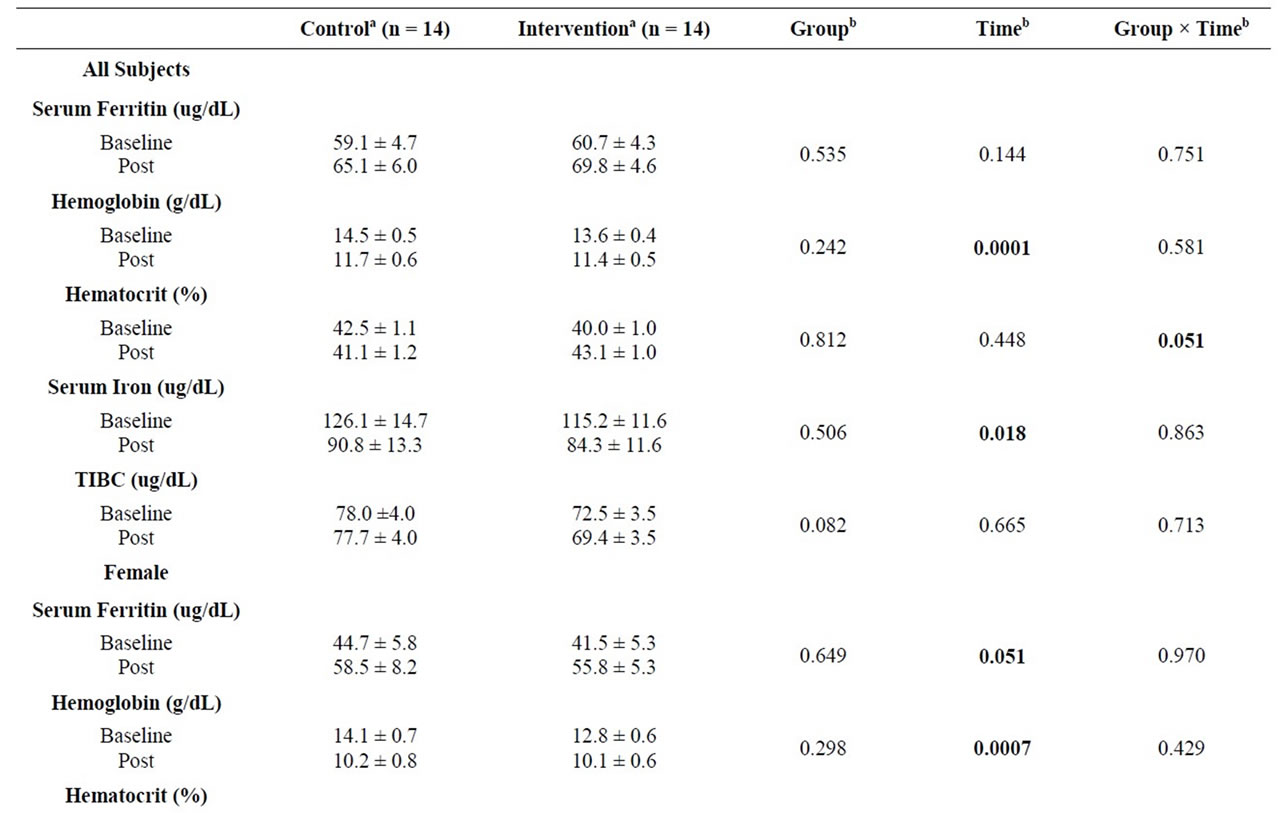

Table 5. Participant blood iron parameters at baseline and 8 weeks.
with this at-risk population. The convenience of additional iron intake in the form of lean beef supplementation reveals the present method used may be effective in the prevention of iron depletion through maintenance of iron stores during a training period. There was no significant difference between groups as an effect of the intervention in calorie, protein, or amino acid intakes, which is noteworthy because both groups in this study had fairly high levels of protein intake, reported between 1.4 - 1.7 g/kg. An athlete who consumes calorie and protein amounts within the recommended range throughout an intense training duration is less likely to experience a change in measures of iron status, body composition or performance [4,10,24-27]. The reported significant difference in calcium intake seen in the control group was due to a decrease in the group’s dairy consumption at the post-intervention data collection. Calcium inhibits the absorption of both heme and non-heme iron, and may have the capability to alter serum ferritin concentrations, although only at specific doses of 300 to 600 mg [28]. After further review, literature clarifies that little effect has been observed on serum ferritin concentrations when calcium intakes range from 1000 to 1500 mg/day [29,30]. Although there were differences in calcium intake between the groups, it is not believed this would impact the iron outcome. The present study’s results reveal the participants’ consumption of calcium was within the recommended ranges, which indicates its lack of influence on serum ferritin levels.
When both genders were combined the findings revealed no significant weight change between groups over time, although there was a significant increase in body fat along with a decrease in lean mass. The results of Freidmann et al. [7] and Magazanik et al. [25] also found a slight decrease in muscle mass was evident due to training and competition by these endurance athletes. However, the present study did not see a significant difference between groups as a result of the beef supplementation. This is inconsistent to results from Heath et al. [18] who reported no lean mass loss with additional protein. The loss of lean body mass is to be avoided, as it can compromise strength and endurance capacity [10,11,20].
The performance of both groups experienced a significant increase over time. However, the reported results can be attested as an effect of training, in which both groups increased consistently. Because these athletes were well trained prior to baseline data collection and intervention, their iron status, body composition and performance measures may lack significant change as an effect of the dietary supplementation. The metabolism of iron and protein, composition of adipose and lean mass tissue, as well as maximal oxygen consumption are well-established in this population due to its long-term consistency and maintenance with a regular training schedule [10,27]. This provides reason for an introduction of the present form of a lean beef supplementation at the beginning of a training regime, with the intention of preventing low-iron intakes.
Even though significant differences between groups as an effect of the intervention were not seen, the trends that did occur in the areas of measurement do follow results of current literature. This lack of significance could be due to sample size. It was calculated a sample size of 57 may be needed to be confident in determining differences in iron status. This study was unique in that the measurement of supplementation effects on endurance athletes was completed on individuals during a competitive season, where the athletes involved underwent a common training and competition schedule and lived a similar lifestyle. The subjects were well nourished based on baseline diet histories and well trained prior to baseline data collection. The differences between the results of this study and other studies may be related to the inconsistencies in training status, intensity and duration among subjects in other studies.
5. Conclusion
In conclusion, endurance athletes, especially women have a tendency to develop low iron stores and iron deficiency. The determination of iron status is difficult to accurately report due to the interaction of various hematological markers with the body’s response to physical activity. Increasing bioavailable iron from red meat may assist in the maintenance of iron stores; however, its direct impact on performance among endurance athletes with a normal iron status is unclear. The change in body composition of this population over the course of a competitive season with the supplementation of lean beef may result in an enhancement in lean mass, although this component requires additional research. The results of this study reveal the willingness of athletes to consume this form of dietary supplementation as part of their training and competition routine. The prevention of iron depletion and deficiency should be emphasized and athletes should be monitored regularly to avoid a potential decrease in health status and performance outcomes.
6. Acknowledgements
The funding for this research was provided by the South Dakota Beef Council and the South Dakota Agricultural Experiment Station.
REFERENCES
- National Institutes of Health, 2011. http://www.nlm.nih.gov/medlineplus
- L. K. Mahan and S. Escott-Stump, “Krause’s Food & Nutrition Therapy,” 12th Edition, Saunders Elsevier, St. Louis, 2008.
- J. Beard and B. Tobin, “Iron Status and Exercise,” American Journal of Clinical Nutrition, Vol. 72, No. 2, 2000, pp. 5945-5975.
- J. R. Berning and S. N. Steen, “Nutrition for Sport and Exercise,” 2nd Edition, Jones and Bartlett Publishers, Sudbury, 2005.
- S. Hinton, C. Giordano, T. Brownlie and J. D. Haas, “Iron Supplementation Improves after Training in Iron-Deficient, Non-Anemic Women,” Journal of Applied Physiology, Vol. 88, No. 3, 2000, pp. 1103-1111.
- J. P. McClung, et al., “Randomozed, Double-Blind, Placebo-Controlled Trial of Iron Supplementation in Female Soldiers during Military Training: Effects on Iron Status, Physical Performance, and Mood,” American Journal of Clinical Nutrition, Vol. 90, No. 1, 2000, pp. 124-131. doi:10.3945/ajcn.2009.27774
- B. Freidmann, E. Weller, H. Mairbaurl and P. Bartsch, “Effects of Iron Repletion on Blood Volume and Performance Capacity in Young Athletes,” Medicine and Science in Sports and Exercise, Vol. 33, No. 5, 2001, pp. 741-746. doi:10.1097/00005768-200105000-00010
- J. J. Lamanca and E. M. Haymes, “Effects of Iron Repletion on VO2max, Endurance, and Blood Lactate in Women,” Medicine and Science in Sports and Exercise, Vol. 25, No. 12, 1993, pp. 1386-1392. doi:10.1249/00005768-199312000-00012
- S. Radjen, et al., “Effect of Iron Supplementation on Maximal Oxygen Uptake in Female Athletes,” Military Medical & Pharmaceutical Journal of Serbia & Montenegro, Vol. 68, No. 2, 2011.
- R. F. Hurrell, “Bioavailability of Iron,” European Journal of Clinical Nutrition, Vol. 51, No. 1, 1997, pp. S4-S8.
- K. Berg, “Endurance Training and Performance in Runners: Research Limitations and Unanswered Questions,” Sports Medicine, Vol. 33, No. 1, 2003, pp. 59-73. doi:10.2165/00007256-200333010-00005
- J. G. Stewart, et al., “Gastrointestinal Blood Loss and Anemia in Runners,” Annals of Internal Medicine, Vol. 100, No. 6, 1984, pp. 843-845.
- R. D. Telford, et al., “Footstrike Is the Major Cause of Hemolysis during Running,” Journal of Applied Physiology, Vol. 23, 2003, pp. 38-42.
- M. J. Gibala, “Protein Metabolism and Endurance Exercise,” Sports Medicine, Vol. 37, No. 4-5, 2007, pp. 337- 340.doi:10.2165/00007256-200737040-00016
- P. Nielsen and D. Nachtigall, “Iron Supplementation in Athletes. Current Recommendations,” Sports Medicine, Vol. 26, No. 4, 1998, pp. 207-216. doi:10.2165/00007256-199826040-00001
- University of Washington, “Iron Absorption,” 2010. http://courses.washington.edu/conj/bess/iron/iron.htm
- National Anemia Action Council, “Anemia,” 2010. http://www.anemia.org/patients/
- A. Heath, M. Skeaff, S. O’Brien, S. Williams and R. Gibson, “Can Dietary Treatment of Non-aNEMIC Iron Deficiency Improve Iron Status?” Journal of the American College of Nutrition, Vol. 20, No. 5, 2001, pp. 477- 484.
- L. Hallberg and E. Bjorn-Rassmussen, “Determination of Iron Absorption from the Whole Diet,” Scandinavian Journal of Hematology, Vol. 9, 1972, pp. 193-197. doi:10.1111/j.1600-0609.1972.tb00930.x
- L. Lamont, “Dietary Protein and the Endurance Athlete,” International Sports Journal, Vol. 7, No. 2, 2003, pp. 39- 45.
- L. Weight, P. Jacobs and T. Noakes, “Dietary Iron Deficiency and Sports Anemia,” British Journal of Nutrition, Vol. 68, 1992, pp. 253-260. doi:10.1079/BJN19920082
- J. D. Cook and E. R. Monsen, “Food Iron Absorption in Human Subjects. III. Comparison of the Effects of Animal Proteins on Non-heme Animal Absorption,” American Journal of Clinical Nutrition, Vol. 29, No. 8, 1976, pp. 859-886.
- D. Garza, et al., “The Clinical Value of Serum Ferritin Tests in Endurance Athletes,” Clinical Journal of Sports Medicine: Official Journal of the Canadian Academy of Sports Medicine, Vol. 7, No. 1, 1997, pp. 46-53. doi:10.1097/00042752-199701000-00009
- L. Burke and V. Deakin V, “Clinical Sports Nutrition,” 3rd Edition, McGraw-Hill Companies, Sydney, 2006.
- A. Magazanik, et al., “Effect of an Iron Supplement on Body Iron Status and Aerobic Capacity of Young Training Women,” European Journal of Applied Physiology, Vol. 62, 1991, pp. 317-323. doi:10.1007/BF00634966
- F. Bokhari, et al., “A Study to Establish Whether FoodBased Approaches Can Improve Iron Levels in ChildBearing Aged Women,” Journal of Human Nutrition and Dietetics, Vol. 25, No. 1, 2011, pp. 1-6.
- M. Burrows and S. Bird, “The Physiology of the Highly Trained Female Endurance Runner,” Sports Medicine, Vol. 30, No. 4, 2000, pp. 281-300. doi:10.2165/00007256-200030040-00004
- L. Hallberg, M. Brune, M. Erlandsson, A. S. Sandberg and L. Rossander-Hulthen, “Effect of Different Ammounts of Nonheme and Heme-Iron Absorption in Humans,” American Journal of Clinical Nutrition, Vol. 53, 1991, pp. 112-119.
- S. K. Ames, B. M. Gorham and S. A. Abrams, “Effects of High Compared with Low Calcium Intake on Calcium Absorption and Incorporation of Iron by Red Blood Cells in Small Children,” American Journal of Clinical Nutrition, Vol. 70, No. 1, 1999, pp. 44-48.
- M. A. Dalton, J. D. Sargent, G. T. O’Connor, E. M. Olmstead and R. Z. Klein, “Calcium and Phosphorus Supplementation of Iron-Fortified Infant Formula: No Effect of Iron Status of Healthy Full-Term Infants,” American Journal of Clinical Nutrition, Vol. 65, No. 4, 1997, pp. 921-926.

